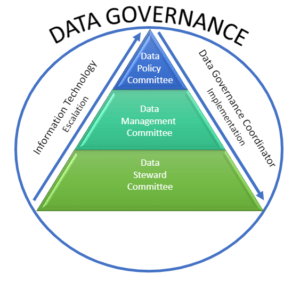Data Governance
Why Data Governance is Important?
Data governance has now become the center of data quality in many organizations. Over the years, importance of data governance has significantly increased, primarily because organizations now preemptively align their data governance process to reduce the data security risks. As an educational agency, NDE takes key initiatives to maintain data to make informed decisions that best support our student’s privacy and ensures overall safety of the data we are entrusted with.
Data Governance at Large
The management of data has now become the one of the most crucial elements for all the organization, and therefore, data governance plays that crucial role in managing that data. According to GAO’s analysis of K-12 Cybersecurity Resource Center (CRC) data from July 2016 to May 2020, thousands of K-12 students were affected by 99 reported data breaches, one type of cybersecurity incident in which data are compromised.
Cloud services has now become an integral part to ensure systematic data governance and educational systems across the US. These cloud services help in appropriately analyze and assess information to mitigate risks to the integrity, confidentiality, and availability of sensitive institutional information and the personally identifiable information (PII) of students, staff, and others.
Data Governance at Nebraska Department of Education
At NDE, key focus is on taking decisions through informed and verified manner by effectively using data resources.
- Data governance bring more insight in matters such as decision making, issue resolution, and collaboratively managing committees like Data Management and Data Stewards Committees.
- Helps in working target focused when budgets are tight with maximum use of resources.
- Given regulations around FERPA, PII, HIPPA, and PTAC, the NDE needs to know where data is at—who is accessing it, where it’s stored, where it’s going, and how it will ultimately be used.
- Data collected from 249 Public School Districts – 989 Schools (58 PK, 543 elementary,124 Middle/Jr. high, 169 Secondary Schools, & 95 High Schools) is maintained and used as per the needs in compliance with various regulations.
Best Practices in Working with Data
Using & Storing Data
The main objective of data storage is to keep it safe. To ensure safety of data, it must be kept in the protected environment, with different accessibility levels as per the requirements. Further ensuring data is encrypted, never saved on personal machines or stored on unauthorized electronics devices like pen drives, hard drives, etc.
Limiting Access Control
Many organizations face issues when contractors or other vendors needs access to company’s data. There are high chances of misusing and disclosing more information than required when data access is granted for outside vendors. To know more, follow along.
Sharing & Sending Data
The main objective of data storage is to keep it safe. To ensure safety of data, it must be kept in the protected environment, with different accessibility levels as per the requirements. Further ensuring data is encrypted, never saved on personal machines or stored on unauthorized electronics devices like pen drives, hard drives, etc.





